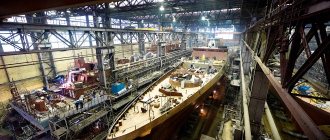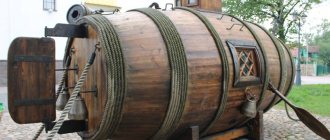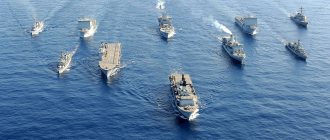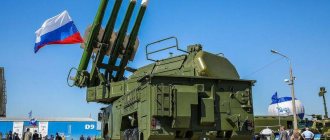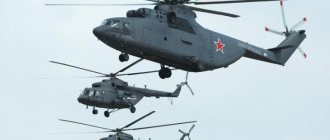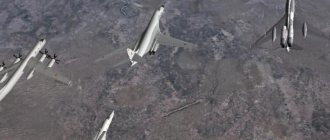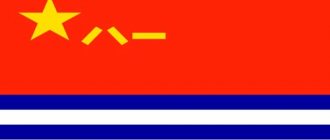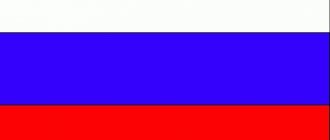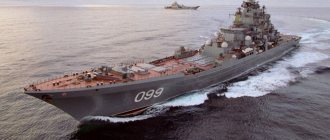History of the Russian Air Force
Formation of troops in the USSR
In 1910, the Imperial Air Force was created. Airplanes are used for reconnaissance, adjusting artillery fire, bombing the enemy, and later as fighters.
From the aircraft that survived the battles of the Civil War, the Workers' and Peasants' Red Air Fleet was formed in 1918, numbering up to 350 aircraft.
After the war, the development of aviation received close attention from the country's leadership, and already in the 30s, production of I-15 and I-16 fighters and TB-1, TB-3 bombers was established.
I-15 fighter
In 1932, the Air Force of the Workers' and Peasants' Red Army became an independent branch of the military, including military, army and front-line aviation.
By the beginning of the Great Patriotic War, the Air Force had more than 20 thousand winged aircraft. However, in the first days of the war, most of the aircraft were destroyed at airfields and in unequal air battles with the invaders. And only thanks to the heroic efforts of designers, engineers, military personnel, workers (not only men, but also women and teenagers) - the entire people, it was possible to reverse the catastrophic situation and revive the country's aviation!
During the four years of the war, about 100 thousand combat aircraft were built. New weapons were developed, the skill of Soviet pilots grew, and the tactics of using aviation to support advancing troops were improved.
IMPORTANT! During 1941 - 1945, the Air Force destroyed about 57 thousand enemy aircraft (in total, 77 thousand German aircraft were destroyed on the Soviet-German front).
In the 40s and 50s, the Air Force was rapidly modernizing: there was a transition from piston to jet aircraft, and new missile weapons and radar systems were being developed. Every year, the country's Air Force receives 400-600 units of aircraft and missile technology.
By the end of the 80s, about 10 thousand aircraft and helicopters were in service.
The current state of the Air Force
After the collapse of the USSR, difficult times came for the Russian Air Force. However, already in 2009, a course was taken to modernize the existing aircraft fleet, and purchases of new equipment approached the procurement figures of the Soviet era.
In modern Russia, the development of military aviation is given paramount importance; sufficient funds are allocated for this from the federal budget. The Russian Air Force has a powerful arsenal and is capable of withstanding any enemy.
Modern aircraft at the Kubinka airfield
[edit] Army aviation
Main article
:
Army Aviation of the Russian Air Force
The army aviation segment of the Russian Air Force is being updated the fastest. Even tactical aviation cannot keep up with helicopters in terms of equipment supplies.[23]
Currently, helicopter units are armed with about 350 attack rotorcraft. Of these, 66 main strike Mi-28N, 40 multi-purpose all-weather combat Ka-52 and 34 transport-combat Mi-35M. The rest - approximately 226 aircraft - are various modifications of the Mi-24 transport and combat helicopter. There are about 450 transport helicopters in the army today. Of these, 40 are super-heavy Mi-26s, the remaining 410 are transport modifications of the Mi-8. About fifty helicopters are used for training purposes. That is, the total number of cars at the moment is 850 units.[24]
In 2013, 8 Mi-28N and 16 Ka-52 have already entered combat units. In addition, aircraft manufacturers delivered one heavy transport helicopter Mi-26, 12 multi-purpose Mi-8AMTSh and 2 Mi-8MTV5. Five Ansat-U training helicopters - 5 and the same number of Ka-226 multi-role helicopters may have been produced in 2012, but delivered in 2013.[25]
Thus, in the first 7 and a half months of 2013 alone, the Russian army has already received 49 new and 1 modernized helicopter. In total, over almost 5 years of deliveries, Russian army aviation received, in addition to the attack ones listed above, two ship-based RLD Ka-31R helicopters, 12 Mi-26, about 150 Mi-8, 24 Ansat-U and 15 Ka-226 units. Total - 343 new helicopters. In addition, one Mi-26 underwent a major overhaul. Based on the construction plans, it is reasonable to assume that by 2022 the total number of helicopters in army aviation will increase by about one and a half hundred units and reach 1,000 helicopters of different classes. Moreover, almost all of them will be relatively new construction.[26]
Air Force structure
The Russian Air Force consists of the following branches of troops (forces):
- Aviation, depending on purpose:
- bomber;
- assault;
- fighter;
- air defense;
- intelligence;
- transport;
- special.
- Anti-aircraft missile forces, whose main function is to protect strategic targets, as well as troop groups from air strikes. Anti-aircraft missile systems and systems are used as weapons, which have high firepower and accuracy.
- Radio technical troops performing reconnaissance functions.
- Special troops.
- Units and institutions of the rear.
MiG-29 fighters
[edit] Links
[edit] Maps
[edit] Other
- Sections on the Sdelanounas website: Russian Air Force, Russian Air Force
- Section about long-range aviation on the website sdelanounas.ru
- Comparison of US and Russian aviation (MIL02)
- VTA of the Russian Air Force tripled the volume of military cargo transportation
- Results of 2012 in pictures: Air Force - part 1 (aircraft)
- Combat aircraft and helicopters for the Russian Air Force (contracts)
- Photos of the new Su-34s at Baltimore airbase
- More than 650 aircraft units entered the army during the re-equipment
- Distant prospects for a long-range bomber
- Russian Tu-95MS strategic bombers performed air patrol missions along the coast of Alaska
- History of the Russian aviation industry[2]
- The arrival of the new Su-34 strike aircraft into service indicates the beginning of real technical re-equipment of the Russian Air Force - Kokoshin
- The Russian Air Force is reaching Soviet-era levels for aircraft purchases
- Soviet markings will be returned to Air Force aircraft
- Russia is developing an attack drone based on the T-50 fighter
- What scared the American destroyer. April 30, 2014
- In 2014, NATO air forces scrambled to intercept Russian aircraft more than 400 times
- How the “Russian Bear” defeated the British on the spot. February 26, 2015
- Electronic warfare complex Khibiny
- National Interest named the best Russian combat aircraft. July 4, 2015
- Russia is reaching military air parity ahead of schedule. September 20, 2015
- KRET: Russian aviation can be protected by disposable “electronic warfare ammunition.” November 30, 2015
- Modernization of Russian strategic bombers. April 17, 2016
Modern Air Force uniform
The uniform for military personnel of the Air Force is created, first of all, for convenience in everyday wear and differs depending on the status of the employee and his gender.
There are several options for uniforms:
- Uniform for privates and cadets, the summer version of which consists of a blue suit, white T-shirt, black boots and a field cap.
- The winter version consists of a camouflage suit, a T-shirt and cap of the same color, a muffler and a khaki coat, black boots and gloves.
- Two options for everyday uniforms have been developed for officers:
- Summer, consisting of blue trousers and a jacket, a blue shirt and a black tie with a gold tack. The headdress is a blue or khaki cap. Black boots are provided for the feet.
- Winter uniform, which is similar to the summer one and is complemented by a gray or blue coat with a gray earflap hat and black gloves.
- The uniform of senior officers is similar, the difference is that it is complemented by a detachable gray astrakhan collar and a gray hat.
- The uniform for female military personnel also has two options:
- Summer, consisting of a blue or khaki skirt and jacket and a similar blouse, as well as a black tie with a gold tack. The headgear is a blue or protective cap. Black or flesh-colored shoes and boots are acceptable as footwear.
- Winter, complemented by a blue or khaki muffler, as well as a blue or gray coat. Headdress – gray astrakhan beret.
REFERENCE. A dress uniform has also been developed for Air Force personnel, which has some differences from everyday
Military uniform of the Russian Air Force
[edit] Reconnaissance aircraft
Main article
:
Reconnaissance aviation of the Russian Air Force
In November 2011, TANTK named after G. M. Beriev transferred the first, and at the end of February 2013, the second serially modernized AWACS A-50U aircraft to the Ministry of Defense. According to the company, the updated vehicle has switched to a new elemental base of the on-board radio engineering complex. In addition, the workplaces of the aircraft’s tactical crew members have been radically modernized. The A-50U received a “glass” cockpit with an abundance of multifunctional LCD indicators. A new communications system has been installed on the plane. Also, unlike the base aircraft, the A-50U has rest rooms for the crew, a buffet with household equipment and a toilet. Currently, work is underway to create the next generation AWACS aircraft - the A-100. According to some experts, this vehicle will surpass the A-50U in its characteristics and will be built on the basis of the Il-76MD-90A. Today's A-50U complex can detect ground targets and determine their coordinates, and detection can include up to 300 objects simultaneously. Bombers are detected at a distance of up to 650 km, fighters - up to 300 km, and columns of tanks - 250 km. Apparently, all these characteristics will be significantly expanded and supplemented in the new reconnaissance aircraft.[22]
Air Force Day
On August 12, 1912, an order was issued according to which the Staff of the Aeronautical Unit of the Main Directorate of the General Staff was put into operation.
Since then, Air Force Day has been celebrated annually on August 12. This holiday was officially established by the Decree of the President of the Russian Federation “On the establishment of professional holidays and memorable days in the Armed Forces of the Russian Federation” dated May 31, 2006 No. 549.
Russian Air Force flag
[edit] Special purpose aviation
Main article
:
Special purpose aviation of the Russian Air Force
For the first time in many years, in the near future the Ministry of Defense will receive 4 special aircraft - two Tu-214R radio-technical and optical-electronic reconnaissance aircraft and two Tu-214ON “Open Skies” air surveillance aircraft. The Ministry of Defense received one of them directly at MAKS 2013. All that is known about the equipment of these aircraft is that it will be the most modern and will allow the crews to perform the functions assigned to them in full. Both contracts are currently being fulfilled by KnAAZ named after S.P. Gorbunov. In addition, one Il-22VKP was modernized.[21]
Russian Air Force
Commander-in-Chief of the Russian Air Force - Army General A.M. KORNUKOV
.
In 2000, the organizational structure of the Air Force did not undergo changes, with the exception of the build-up of Air Force forces in the North Caucasus. Formations of two types have been preserved. Two air armies are directly and operationally subordinate to the High Command of the Russian Air Force
Supreme High Command
(VA VGK)
-
37th
VA VGK (DA) and
61st
VA VGK (VTA).
The following associations and formations formed in 1998 are directly subordinate to the High Command of the Russian Air Force, but are under the operational leadership of the commanders of the military districts formed in 1998: Moscow Air Force and Air Defense District
(MVO),
4 Air Force and Air Defense Armies
(6th Army (LenVO), headquarters - St. Petersburg; 4th Army (Siberian Military District), headquarters - Rostov-on-Don; 11th Army (Far Eastern Military District), headquarters - Khabarovsk; 8th Army (Siberian Military District), headquarters - St. Petersburg; Chita),
2 Air Force and Air Defense Corps
(5th Corps (PriVO), headquarters - Saratov; 3rd Corps (Ural Military District), headquarters - Yekaterinburg).
In accordance with the military development plans approved at the Security Council meeting on November 9, 2000, the Air Force is reducing its staffing levels
by
36 thousand
people (10% of the total reduction in the number of armed forces).
By reducing personnel, the Air Force command plans to increase the staffing level of all units and subunits to 95%
.
By 2005-2006
The Strategic Missile Forces may become part of
Force
, but the final decision has not yet been made.
Decisions to deploy groups in the North Caucasus and Central Asian directions led to the development of plans to build up air force forces. For these purposes in 2002-2005.
It is planned to form
two air force and air defense armies
as well as
2-4 air divisions
, which will be focused on solving combat missions in the interests of new groups.
At the same time, it is planned to increase the number of units of constant readiness to 50%
.
It is planned to soon return to the status of Commands
long-range (currently the 37th VA VGK (DA) and military transport aviation (currently the 61st VA VGK (VTA).
During 2001-2002.
It is planned to merge several air regiments with the combat strength of the new units being increased to three squadrons.
Reinforced regiments
will be armed with
36-40
aircraft and
1.5 - 1.7
sets of flight personnel.
In 2000, the management system continued to be improved
Air Force and Air Defense.
Currently, the creation of an integrated automatic control system
for various forces and means of aviation and air defense of the
“Universal”
in the regions and in strategic directions is being completed.
The first automated control system
and
the Moscow Air Force and Air Defense District
received a new generation command post (CP) .
A similar system is being implemented in the air defense system of the Kaliningrad Special Region
.
The 4th Air Force and Air Defense Army (SKVO)
received a new mobile command post .
In order to save funds, in the summer of 2000, the Air Force Commander-in-Chief decided to reduce the level of readiness when on combat duty.
some units of the anti-aircraft missile forces (ZRV). First of all, these are regiments and divisions of air defense forces covering objects deep in Russian territory. There are no plans to deploy a continuous air defense system across the country - 20-25 permanent air defense regiments will cover the areas of Kamchatka, Primorye, Khabarovsk Territory, and Chita. Novosibirsk, Ural, Samara region, Central and North-Western regions, as well as the Kaliningrad special region.
Military educational institutions of the Air Force (1 military academy, 2 military universities, 7 military institutes of higher education) graduated about 4.7 thousand during 2000 .
officers (in 1998-1999 - 6.5 thousand),
83%
of whom were sent to Air Force and Air Defense units, the rest were assigned to other types and branches of the Armed Forces.
The current staffing level for officer positions in the Air Force is 97%
.
4.5 thousand left the service in 1998-2000)
young officers who graduated from college in 1995-1999), the class pilots are aging.
Combat composition of the Russian Air Force
Total combat strength of the Russian Air Force as of December 2000
amounts to
5087
aircraft and helicopters
35
types and
85
modifications 9 according to official data).
833
at reserve bases .
more than 100%
equipped with all types of aircraft and helicopters , with the exception
of Il-78M tanker aircraft
.
In 2000, the fleet of long-range strategic bombers increased noticeably ( 37th VA VGK
).
8
Tu-160
missile carriers ,
3
Tu
-95 MS
and
575
Kh-55
and
Kh-55SM
cruise missiles were transferred .
On May 5, 2000, the 37th VA VGK received a new missile carrier Tu-160 (named Alexander Molodchiy), built at the Kazan Aviation Production Association (KAPO). In July
KAPO began the modernization and overhaul of the Tu-160 aircraft, which was in trial operation at the Flight Research Institute named after.
Gromov (Zhukovsky, Moscow region). It is planned to modernize another 15 Tu-160 aircraft
.
Combat composition of the Russian Air Force
| 1999 | 2000 | |
| Long-range aviation Total combat aircraft | 191 | 244 |
| Strategic aviation, incl. | ||
| Tu-160 | 6 | 15 |
| Tu-95MS | 60 | 71 |
| Long-range bombers and reconnaissance aircraft of the Tu-22M, Tu-22M2 and Tu-22M3 families | 125 | 158 |
| Il-78 and Il-78M refueling aircraft | 20 | 20 |
| Frontline aviation and air defense aviation Total combat aircraft | 2040 | 1590 |
| Strike aircraft Total combat aircraft incl. | 725 | 575 |
| Su-24M front-line bombers | 475 | 350 |
| Su-25 attack aircraft | 250 | 225 |
| Fighter aircraft Total combat aircraft incl. | 1115 | 880 |
| MiG-29 (MiG-29M) fighters | 315 | 260 |
| Fighters of the Su-27 family | 375 | 340 |
| MiG-31 interceptor fighters | 425 | 280 |
| Reconnaissance aircraft Total combat aircraft incl. | 200 | 135 |
| MiG-25R | 40 | 15 |
| Su-24MR | 160 | 120 |
| A-50 AWACS and control aircraft | 20 | 20 |
| Military transport aviation Total aircraft | 340 | 280 |
Bombers and reconnaissance aircraft outside combat units of the Air Force: in test units, design bureaus, research institutes and factories - 7 Tu-95 and 5 Tu-160; in storage - 92 Tu-22M1 and Tu-22M2; in training units - 10 Tu-22M2.
Additionally, the Air Force combat training centers include over 150 combat aircraft (40 MiG-29, 10 MiG-25, 50 Su-24, 10 Su-27, 25 Su-25), more than 800 aircraft are located at storage bases (MiG-23 , MiG-27, Su-17 and Su-22 of various modifications). Up to 1,000 combat aircraft are operated by Air Force universities.
Air Force losses in accidents and plane crashes for 2000
| Type of aircraft (helicopter) | Quantity |
| MiG-31 | 1 |
| Su-25 | 1 |
| Su-24 | 5 |
| IL-18 | 1 |
| IL-76 | 1 |
| Mi-8 | 2 |
| Total | 11 |
One of the main problems
The Air Force remains
with an aging aircraft fleet
.
Up to 80%
of machines are operated
by extending their service life
.
Age of Russian Air Force aircraft
| Age | Number of total Air Force fleet (%) |
| over 15 years old | 48 |
| from 10 to 15 years | 23 |
| from 5 to 10 years | 28 |
| 5 years or less | 1 |
In 2000, due to insufficient funding, the share of serviceable vehicles decreased
.
The capacity of aircraft repair plants
is used at only
27%
.
| Branch of aviation of the Russian Air Force | Share of serviceable machines (%) |
| Long-range aviation | 79 |
| Military transport aviation | 62 |
| Frontline aviation | 56 |
During 2000, the crisis in the Air Force support system and infrastructure
.
60% of airfield runways
are in a pre-emergency condition ,
40%
of them require additional equipment or major repairs.
Share of modern equipment in radio engineering troops and communications units
Air Force makes up
15 %
.
Russian Air Force combat training
12 thousand people go on combat duty
people,
35 anti-aircraft missile divisions
,
30 fighter aviation crews
, and up to
100 radio engineering units
.
In 2000, the intensity of combat training of the Air Force practically remained at the 1999 level, but decreased by almost 3 times
the number of combat training launches of air-to-surface missiles due to the high consumption of this type of ammunition during the operation in the North Caucasus. Also, the number of combat launches of missile defense by anti-aircraft missile forces (ZRV) of air defense has decreased, and the number of firings in air defense aviation has also decreased.
400 exercises
and trainings
were conducted (in 1999 - more than 300),
50% of air defense regiments
carried out live firing (in 1999 - 90%).
Frontline aviation conducted 30 tactical flight exercises
,
50% of aviation regiments
practiced missile firing at air targets, and over
200 firing
of air-to-ground missiles was carried out (600 firing in 1999).
The nature and theme of the Air Force exercises demonstrate that currently all aviation forces (including the Air Force) are aimed at practicing complex actions in low-intensity conflicts (especially in the Southern direction), which tend to escalate into a local or regional war.
The largest exercises of the Russian Air Force in 2000.
| Time spending | The forces involved and the nature of the tasks being worked out |
| April 18-21 | For tactical exercises held in the Volga region, over the Caspian and Black Seas (South-Western direction ) DA forces were brought in from In the Black Sea operational zone, the DA interacted with the forces of the 4th VA Air Force and Air Defense and Su-30 fighters and |
| April 20-21 | On Ashuluk training ground (Astrakhan region) Comprehensive exercises of the aviation and air defense forces of the Russian Air Force took place. Part of the regiment's combat crews were transferred to the training ground by air, where they were joined by cadets from the Yaroslavl Anti-Aircraft Missile Institute (previously, cadets were not involved in the exercises). The combat crews, having accepted the equipment from the training ground personnel, began practicing tasks to repel a raid by Su-24M front-line bombers (Lebyazhye airbase) striking ground targets with April 21 Tu-22M3 They practiced the bombing of the GDP, while the attacking aircraft themselves were targets for air defense systems. |
| 9-16 August | Research exercises of aviation and air defense of the Russian Air Force “Defense-2000” at the During the exercise, the NATO air operation in the Balkans in 1999 was simulated and the capabilities of a mobile automated reconnaissance and fire group of air defense forces of the Air Force and Ground Forces were studied in a competitive mode. S-300PMU1 “Favorite” air defense system operated and fired. , control elements of strike aviation were tested using the guidance points of aircraft gunners. equipment for decoy positions of the S-300PM air defense missile system division was also tested , which is a quick-deploying pneumatic mock-up of the complex elements. As a result of the exercises, Air Force complexes linked to the integrated automated control system “Baikal” and |
| november | November 9, 2000 two
As stated by the commander of the 11th VA, Aviation Lieutenant General Anatoly Nogovitsin , “When our planes appeared, the Americans were in a panic. They began to cut the communications through which the aircraft carrier was being refueled. At that moment, American carrier-based aircraft were not ready to counteract.” 7
The purpose of the exercise was for long-range aviation crews to practice operations in Arctic conditions from forward-based airfields. |
In 2000, due to financial and economic reasons, the decline in flying hours
hours by Russian Air Force pilots, the average was
25 hours
. Only pilots of attack, bomber and reconnaissance aircraft who took an active part in hostilities in the North Caucasus have a satisfactory flight record.
Flight hours by type of aviation of the Russian Air Force
| Branch of the Air Force | Flight hours |
| Fighter | 10 |
| Assault | 35 |
| Bomber | 20 |
| Far | 10 |
| Military transport | 50 |
As Air Force Commander-in-Chief General of the Army A. Kornukov stated, speaking at a meeting of the Ministry of Defense in the fall of 2000, the state of combat training of flight personnel has reached a level at which the Air Force may lose the ability to carry out the tasks assigned to them. The main thing today was considered to be the preservation of flight personnel and the improvement of the professional skills of young pilots.
Air Force in combat in the North Caucasus
During the anti-terrorist operation in the North Caucasus (in Dagestan and Chechnya), the Air Force decided more than 50%
tasks for fire support of troops, striking designated targets and transporting troops.
Between August 1999 and February 2000 more than 6 thousand sorties
, of which
35%
were for bombing and attacking ground targets,
!0%
for the transfer of troops, the rest for reconnaissance, target designation and other tasks.
involved in the operation in the North Caucasus
units
of the 4th Army of the Air Force and Air Defense
,
two regiments of the Moscow Air Force and Air Defense District
, units of
the Center for Combat Use and Retraining of Flight Personnel of the Russian Air Force
.
Su-24 front-line bombers were mainly used to attack gangs.
and
Su-24M
, as well as
Su-25
.
During air operations, the problem associated with the lack of multifunctional front-line aircraft in the Air Force became acutely apparent, as a result of which the combat load fell on the most worn-out part of the aircraft fleet. Of the relatively modern vehicles, only modernized Su-25T
, equipped with high-precision weapons, were used.
During the operation in the North Caucasus, the Air Force faced a shortage of precision weapons
(WTO). Precision-guided munitions from the Air Force Reserve were used. The leadership of the Air Force High Command appealed to the government and the Ministry of Defense with a request to take decisive measures to order from industry and replenish WTO reserves.
To solve air defense problems
In the combat area,
two
Su-27
fighters , as well as
Su-25
and
Mi-24
, capable of destroying helicopters and light aircraft.
During the anti-terrorist operation, an organizational problem
, associated with
the reduction in the 90s.
units and units of logistics and logistics support for the Air Force.
Based on the results of the operation, the General Staff decided to increase the combat strength of the Air Force in the North Caucasus, increase the number of permanent readiness units and bring their staff to wartime standards.
Cooperation within the framework of the Unified Air Defense System (US) of the CIS countries
In 2000, the exercises within the framework of the air defense system were complex in nature - joint actions of aviation forces and air defense systems of the Commonwealth countries were practiced. The largest tactical exercise of the CIS member states “Combat Commonwealth-2000”
took place at the Ashuluk training ground (Astrakhan region) from
August 21 to 26, 2000
under the leadership of the Chairman of the Coordination Committee on Air Defense Issues under the Council of Defense Ministers of the CIS Countries - Commander-in-Chief of the Russian Air Force Anatoly Kornukov. Air defense forces from Armenia, Belarus, Kyrgyzstan, Kazakhstan, Russia, Tajikistan, Uzbekistan and Ukraine took part in the maneuvers.
By the end of 2000, as part of the integration of the Union of Russia and Belarus, the formation of a unified air defense system in the western direction began. Since March 14, 2000
Kyrgyzstan joined the joint air defense combat duty of Russia, Armenia, Belarus, Kazakhstan and Tajikistan, and Uzbekistan joined in
July
.
Modernization of the aircraft fleet and prospects for the technical policy of the Russian Air Force
According to experts, existing aircraft models will last until 2010.
(fighter and front-line aviation).
Long-range
aircraft will be able to remain in service
until 2016.
In the period 2001-2007.
it is planned to implement
a program to modernize
the main aviation systems of the Air Force (MiG-29, Su-24, Su-25, Su-27, Su-30, Tu-22M3, Tu-95MS and Tu-160).
Mass deliveries of new types of military equipment
in terms of the Air Force are expected no earlier than the period
2008-2010.
Contractors for the modernization of the main combat aircraft of the Russian Air Force
| Aircraft type | Contractor |
| Tu-160 | Kazan Aviation Production Association named after. Gorbunova (KAPO) |
| Tu-95MS, Tu-22M3 | Aircraft repair plant No. 360 (Ryazan) |
| Su-27 | Komsomolsk-on-Amur Aviation Production Association (KNAAPO) |
| Su-27UB, Su-30 | Irkutsk Aviation Production Association (IAPO) |
| Su-24M | Novosibirsk Aviation Production Association (NAPO) |
| Su-25 | Russian Air Force Aircraft Repair Plant (Kubinka, Moscow region) |
| MiG-31 | Aircraft plant “Falcon” (Nizhny Novgorod) |
In 2001-2002 limited supplies will begin
to the Air Force combat units of the new multifunctional
Su-34 (Su-27IB)
.
According to unofficial information, testing of a new version of this aircraft with improved avionics will begin in the near future (flight tests were completed in 2000, the Su-34 aircraft took part in exercises at the Ashuluk training ground). In 2000, an order
for
2
Su-25T
attack aircraft , the construction of which is underway at the Ulan-Ude Aviation Plant (funds were allocated from the state order for 1999).
The management of the Sokol aircraft plant (Nizhny Novgorod) stated that in 2001 the enterprise will build 4
Yak-130
aircraft in training and combat versions.
According to official reports, in 2000 a schedule was developed for the supply of new An-70
, however, after the crash of an aircraft of this type near Irkutsk on January 26, 2001, disagreements in the Air Force leadership regarding priority BTA programs intensified.
Some Air Force leaders insist on purchasing the Il-76MF
(currently there are 8 fuselages on the stocks of the Tashkent Aviation Production Association, 4 aircraft have been assembled, their flight tests have begun) and the
S-80
of the Sukhoi Aircraft Production Association.
In addition, in 2000, the Il-76MF with PS-90 engines received a conclusion on the completion of certification tests. It is planned to purchase up to 120
vehicles of this type.
Modernization began in 2000
front-line, fighter and bomber aircraft.
In 2000, 4
Su-25
attack aircraft .
Work was also carried out to improve the characteristics of the avionics of front-line Su-24M
.
The Air Force leadership pays special attention to
Tu-95MS
strategic bombers (work is being carried out at aircraft repair plant No. 360, Ryazan),
Tu-160
and
Tu-22M3 long-range bombers
.
Missile development programs are also underway.
YES Air Force. The main task of this work is to give DA aircraft the ability to operate effectively not only in nuclear, but also in conventional conflicts using high-precision weapons with conventional warheads.
Priority work is underway on the new strategic missile X-101
and its
non-nuclear variant X-102
(developed by NPO Raduga).
The first test launches of new missiles were carried out in 1999 - early 2000. Tests of the non-nuclear high-precision ALCM Kh-65S(E)
, created on the basis of the main Air Force missile launcher
Kh-55SM
.
The modernized Tu-95MS will be able to carry 8
Kh-101(102)
missiles on drum launchers in expanded intra-fuselage compartments,
modernized Tu-160
-
24
missiles in two weapons bays.
Development of medium-range missile launcher X-SD
, in which it is planned to use a number of components and the guidance system of the KR X-101.
Modernization of Tu-22M3 aircraft has begun at the 360th Aircraft Repair Plant
to the
Tu-22M5
.
The new vehicle will be able to carry 4 Kh-101(102)
missiles and missiles created as a result of a deep modernization
of the Kh-22M missile
(in the nuclear version -
Kh-22
) with an improved engine and seeker.
Air Force specialists have completed the development of measures to
the MiG-31
fighter-interceptor .
It is planned to upgrade the currently in service vehicles of this type to the MiG-31M(DS)
and give it the ability to work as a command post for ground-based air defense systems.
In 2000, the final decision was made on the modernization
The main
heavy
air superiority fighters of the Russian Air Force
are Su-27, Su-27UB and Su-30
. This program is considered one of the highest priorities for the Russian Air Force.
The Su-30KN (“aircraft 302”) was adopted as the base version.
, created at the Irkutsk Aviation Production Association (IAPO).
First of all, the two-seat Su-27UB (Su-27UBM variant)
and
Su-30 (Su-30M variant)
.
The aircraft is equipped with expanded cockpit instrumentation with a multifunctional display and a new sighting system, created on the basis of technical solutions and equipment under the modernization program for MiG-29
(
MiG-29SMT
). The developer of the equipment is JSC Russian Avionics. In 1999-2000 The car was successfully tested in Akhtubinsk and was demonstrated at the air show in Gelendzhik in September.
“Russian Avionics”, with the participation of IAPO specialists, made changes and additions to the software developed for the MiG-29SMT. New avionics elements were introduced, including the Baguette-55 processor
(developer: KB “Korund”).
The SUV-27
weapons control system was also improved , which ensured the effective use of air-to-surface weapons.
“MVK” operates on the “bypass channel” principle.
, created by Russian Avionics based on the Intel 80486 processor. Its characteristic features are redundancy, open architecture, and data exchange via the MIL-1553B multiplex bus.
Refinement of the SUV-27 system and installation of the MVK machine made it possible to supplement the capabilities of the standard N001 radar antenna with terrain mapping modes, the use of a synthetic aperture and selection of moving targets, including the “tank” type at a range of up to 100 km with a resolution of 20 m. Aircraft “Board 302” gained the ability to destroy ground and surface targets with guided missiles at any time of the day. The aircraft is equipped with an AIST information transmission system capable of transmitting radar, thermal imaging and television images of a target and its coordinates to attack aircraft and helicopters.
The use of missiles required minor changes to the cockpit information and control field - instead of the standard monochrome indicator at the top right of the instrument panel, a multifunctional MFI-55 indicator
with a color liquid crystal matrix. The indicator works in graphic and television modes.
MFI-55 is a square screen with a side of 13 cm, with a graphics processor. There are 20 buttons around the perimeter of the screen. With their help, the operating modes of the radar and weapons are controlled. One MFI-55 is installed in the pilot and operator cockpits.
In the course of further modernization, it is possible to conduct multi-channel fire at several air targets, while the existing RLPK-27 antenna is replaced with a phased array antenna. The cabin is equipped according to the MiG-29SMT type, where two MFIs are installed for the pilot and three for the operator.
The unification of the MiG-29SMT and Su-30KN allows for modernization within the framework of a single program. This approach is supported by the Air Force Research Institute and the leadership of the Russian Defense Ministry.
According to specialists from the Air Force Commander-in-Chief, new functionality and unification of equipment and weapons will allow the Russian Air Force to have a combination of heavy Su and light, highly maneuverable MiGs in front-line fighter aviation groups at minimal financial costs.
The issue of equipping Su-27 family aircraft with air-launched operational-tactical missiles
complex of the Ground Forces (probably referring to
the OTR “Iskander”
-
P.G.
), however, a final decision on this issue has not yet been made.
According to the leadership of the Air Force Commander-in-Chief, work is currently underway to create a single universal (multi-mode) missile
for Air Force aviation.
9M96
surface-to-air missile , the air-to-air version of which (
KS-172
) is already ready for flight tests. Development work on the air-to-surface variant continues.
In 2000, testing of the promising S-400 Triumph
, however,
using missiles
S-300PMU1
complex (5V55 and 48N6) and the
S-300PMU2 Favorit
(48N6E2)
Tests of the S-400
with
the new generation 9M96E
and
9M96E2
and the standard
40N6
will begin in 2001. By mid-2001, it is planned to complete a set of tests and by the end of the year put the first division of the S-400 complex on combat duty.
The inevitable aging of the aircraft fleet with limited budgetary funding for the production of new aircraft models forces the Air Force leadership to focus on the development of R&D
on
5th generation multifunctional aircraft
.
Aircraft 1.44 currently undergoing testing (RSK MiG)
and
S-37 “Berkut” (AVPK “Sukhoi”)
do not yet meet the requirements of the tactical and technical specifications of the Air Force and are experimental prototypes.
JSC Lyulka-Saturn continues work on fine-tuning the promising multi-mode turbojet engine with an afterburner and deflectable thrust vector AL-41F
, intended for 5th generation aircraft.
In 2000, the development of the concept of a promising aviation complex was completed, with which industry representatives were familiarized. The development of tactical and technical specifications is nearing completion. To concentrate forces and resources for work on IFI
(“Multifunctional fighter”) and
LFI
(“Light front-line fighter”), it is planned
to
unite
the largest Russian developers and manufacturers of aircraft
- AVPK Sukhoi, RSK MiG and OKB im.
Yakovleva .

